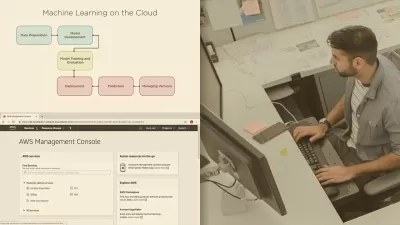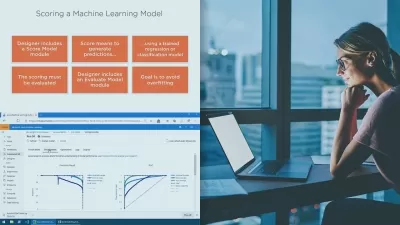AZ-305 Designing Microsoft Azure Infrastructure with SIMS!
John Christopher
15:41:35
Description
Get prepared for the AZ-305 exam with instructor led labs and hands on simulations available 24/7
What You'll Learn?
- Learn the concepts and perform hands on activities needed to pass the AZ-305 exam
- Gain a tremendous amount of knowledge involving advanced Azure services
- Get loads of hands on experience with advanced Azure services
- Utilize hands on simulations that can be access anytime, anywhere!
Who is this for?
What You Need to Know?
More details
DescriptionWe really hope you'll agree, this training is way more than the average course on Udemy!
Have access to the following:
Training from an instructor of over 20 years who has trained thousands of people and also a Microsoft Certified Trainer
Lecture that explains the concepts in an easy to learn method for someone that is just starting out with this material
Instructor led hands on and simulations to practice that can be followed even if you have little to no experience
TOPICS COVEREDÂ INCLUDINGÂ HANDSÂ ONÂ LECTUREÂ ANDÂ PRACTICEÂ TUTORIALS:
Introduction
Welcome to the course
Understanding the Microsoft Environment
Having a Solid Foundation of Active Directory Domains
Having a Solid Foundation of RAS, DMZ, and Virtualization
Having a Solid Foundation of the Microsoft Cloud Services
Order of concepts covered in the course
Questions for John Christopher
Setting up for hands on
IMPORTANT Using Assignments in the course
Creating a trial Microsoft 365/Azure Account
Adding a subscription to your Azure account
Creating some resources to use in the course
Design a solution for logging and monitoring
Starting content for AZ-305
Designing log routing based on the appropriate level of logging
Using the appropriate level of metric logging in Azure monitor
Log routing using a log analytics workspace
Setting up an alert strategy in Azure monitor
Using insights in Azure monitor
Using the Azure Advisor for strengthening your environment
Implementing a solution for DDos protection
Design authentication and authorization solutions
Authorization in the Microsoft cloud service environment
Clarifying role-based access control (RBAC) in Azure
Implementing a solution for role-based access control in Azure
Role-based access control concepts with Privileged Identity Management (PIM)
Using PIM to manage role-based access control in Azure
Identity management for guests using access reviews in Azure
Design governance
Organizational and hierarchical structure for Azure resources with scopes
Identity management by utilizing access management groups
Organizational management with administrative units
Utilizing defender for cloud to strengthen administrative governance
Using Microsoft Defender for Cloud to locate vulnerabilities in Azure
Design identities and access for applications
Identity and application access with zero trust concepts
Azure Key Vault access control
Generating Azure Key Vault keys, secrets & certificates for use with app & more
Key rotation with Azure Key Vaults
Visualizing application access registration concepts with Azure AD
Configuring an application registration with Azure AD, part of Microsoft Entra
Using an Azure app proxy for allowing application access through Azure
Exploring the configuration of an Azure application proxy
Removing un-needed resources before starting the next lesson
Design a data storage solution for relational data
Understanding the role storage accounts play as a storage solution
Adding a storage account for use in Azure
Configuring network access to storage accounts
Configuring a storage account for Azure AD authentication
Working with access keys on a storage account
Using shared access signature (SAS) tokens in regards to storage accounts
Implementing stored access policies
Understanding the use of storage redundancy in Azure
Implementing storage redundancy in Azure
Performing object replication
Managing Azure file shares and storage tiers
Working with Blob storage management
Blob lifecycle management with Azure storage
Understanding relational databases
Understanding database service tier sizing
Visualizing solutions for database scalability
Design data integration
Creating an Azure VM with SQL as a relational data storage solution
Assigning a Public Azure DNS name to your Azure SQL VM
Using SSMS (SQL Server Management Studio) to connect to an Azure SQL VM solution
Removing the un-needed SQL resources
Providing a solution for relational data using the Azure SQL databases resource
Managing client connections with the SQL firewall settings
Implementing database auditing
Recommend a data storage solution
Relational, semi-structured, and non-relational data storage solutions in Azure
Configuring a solution for data authentication
Utilizing Azure SQL dynamic masking
Implementing database encryption
Removing existing objects
Enabling Microsoft Defender for SQL
Design a data storage solution for non-relational data
Understanding non-relational data and NoSQL
Capacity planning to balance features, performance, and cost
Implementing a non-relational Cosmos database solution in Azure
Creating a container for non-relational data storage
Using replication for protection and durability
Understanding data lake storage
How to create a data lake storage account
Understanding Azure Databrick Storage
Visualizing the use of Azure Synapse
Registering Synapse as a resource provider
Adding a SQL DB and server for use with Synapse
Creating a Synapse workspace and Data Lake Storage account
SQL Pool usage with Azure Synapse
Creating a SQL Pool for usage with Azure Synapse
Understanding the Azure Data Factory
Setting up an Azure Data Factory resources
Using Azure Data Factory copying data into Azure Synapse Analytics
Removing data storage resources that are no longer needed
Design a solution for backup and disaster recovery
Recovery Time Objective [RTO], Recovery Level Objective [RLO], Recovery Point Objective [RPO]
Backup and recovery solutions using a Recovery Services Vault
Backup policies for Recovery Time Objectives [RTO] & Recovery Point Object [RPO]
Implementing Azure backup for storage and compute resources
Viewing reporting data involving Azure backup and recovery
Design for high availability
Using availability zones as a high availability solution in Azure
Design concepts for Azure Site Recovery
Azure Site Recovery networking
Understanding recovery plans
Implementing a high availability solution for VM compute resources
Testing a failover high availability solution for VM compute resources
Creating a second storage account for storage high availability
Replicating data storage to provide high availability
Design a compute solution
Understanding Windows 365 and Azure Virtual Desktop as a computer based solution
Host pool architectures with Azure Virtual Desktop compute solutions
Understanding the container-based compute solution in Azure
Implementing a container-based compute solution in Azure
Using container groups to help manage multiple container-based computer solutions
Using Azure Kubernetes Service (AKS) compute solutions
Azure Kubernetes Service scaling
Design an application architecture
Recommend Azure messaging and event-driven architecture options
Installing Microsoft Visual Studio for application development
Setting up Azure DevOps for application development and management
Creating a DevOps project and assigning tasks
Using Visual Studios to upload an application project to Azure DevOps
Creating a pipeline for a DevOps application
Committing application changes through the pipeline with Visual Studios
Introduction to deploying a DevOps application to an App Service
Understanding App Service Plans for deploying web applications
App Service Plan deployment in Azure
Implementing App Service plan scaling
Creating an App Service deployment
Network configuration within App Services
App Service deployment configuration management settings
Utilizing custom domain names with an Azure App Service
Performing backups for an App Service deployment
API Management and integration in Azure
Design migrations
Visualizing migration solutions for storage, VMs, and databases to Azure
Using import and export jobs for data migrations
Migrating data with storage explorer and azcopy
Setup a SQL Server to migrate data from
Setup an Azure SQL Database as our migration destination
Adding a table of data to migrate
Installing Azure Data Studio and the Azure SQL Migration plugin needed for migration
Migrating SQL data from a source SQL service to a destination SQL service
Clearing resources before moving on
Design network solutions
Plan and implement network segmentation and address spaces
Creating VNets based on network architecture workload requirements
Providing a connectivity solution with peering
Planning subnets for Azure resource connectivity workload requirements
Implementing subnet delegation for supporting various Azure resource workloads
Using prefixes with public IP addresses in Azure network architecture
Recommending when its appropriate to use public IP address prefixes
Planning a custom public IP address prefix (bring your own IP) solution in Azure
Allocating an address from a public IP address prefix to support workload requirements
Associating an address from a public IP address prefix to an Azure resource
Understanding how NSGs and ASGs help optimize network security in Azure
How an Azure Firewall can help optimize network security
Deploy an Azure Firewall and route table to optimize network security
Cleaning up existing networking resources
Understanding usages for Azure load balancing solutions
Use cases for Azure load balancers
Setting up a load balancing solution for VMs to host web applications
Verifying health probes for proper load balancing traffic routing
Who this course is for:
- IT people interested in learning and passing the Microsoft AZ-305 exam!
We really hope you'll agree, this training is way more than the average course on Udemy!
Have access to the following:
Training from an instructor of over 20 years who has trained thousands of people and also a Microsoft Certified Trainer
Lecture that explains the concepts in an easy to learn method for someone that is just starting out with this material
Instructor led hands on and simulations to practice that can be followed even if you have little to no experience
TOPICS COVEREDÂ INCLUDINGÂ HANDSÂ ONÂ LECTUREÂ ANDÂ PRACTICEÂ TUTORIALS:
Introduction
Welcome to the course
Understanding the Microsoft Environment
Having a Solid Foundation of Active Directory Domains
Having a Solid Foundation of RAS, DMZ, and Virtualization
Having a Solid Foundation of the Microsoft Cloud Services
Order of concepts covered in the course
Questions for John Christopher
Setting up for hands on
IMPORTANT Using Assignments in the course
Creating a trial Microsoft 365/Azure Account
Adding a subscription to your Azure account
Creating some resources to use in the course
Design a solution for logging and monitoring
Starting content for AZ-305
Designing log routing based on the appropriate level of logging
Using the appropriate level of metric logging in Azure monitor
Log routing using a log analytics workspace
Setting up an alert strategy in Azure monitor
Using insights in Azure monitor
Using the Azure Advisor for strengthening your environment
Implementing a solution for DDos protection
Design authentication and authorization solutions
Authorization in the Microsoft cloud service environment
Clarifying role-based access control (RBAC) in Azure
Implementing a solution for role-based access control in Azure
Role-based access control concepts with Privileged Identity Management (PIM)
Using PIM to manage role-based access control in Azure
Identity management for guests using access reviews in Azure
Design governance
Organizational and hierarchical structure for Azure resources with scopes
Identity management by utilizing access management groups
Organizational management with administrative units
Utilizing defender for cloud to strengthen administrative governance
Using Microsoft Defender for Cloud to locate vulnerabilities in Azure
Design identities and access for applications
Identity and application access with zero trust concepts
Azure Key Vault access control
Generating Azure Key Vault keys, secrets & certificates for use with app & more
Key rotation with Azure Key Vaults
Visualizing application access registration concepts with Azure AD
Configuring an application registration with Azure AD, part of Microsoft Entra
Using an Azure app proxy for allowing application access through Azure
Exploring the configuration of an Azure application proxy
Removing un-needed resources before starting the next lesson
Design a data storage solution for relational data
Understanding the role storage accounts play as a storage solution
Adding a storage account for use in Azure
Configuring network access to storage accounts
Configuring a storage account for Azure AD authentication
Working with access keys on a storage account
Using shared access signature (SAS) tokens in regards to storage accounts
Implementing stored access policies
Understanding the use of storage redundancy in Azure
Implementing storage redundancy in Azure
Performing object replication
Managing Azure file shares and storage tiers
Working with Blob storage management
Blob lifecycle management with Azure storage
Understanding relational databases
Understanding database service tier sizing
Visualizing solutions for database scalability
Design data integration
Creating an Azure VM with SQL as a relational data storage solution
Assigning a Public Azure DNS name to your Azure SQL VM
Using SSMS (SQL Server Management Studio) to connect to an Azure SQL VM solution
Removing the un-needed SQL resources
Providing a solution for relational data using the Azure SQL databases resource
Managing client connections with the SQL firewall settings
Implementing database auditing
Recommend a data storage solution
Relational, semi-structured, and non-relational data storage solutions in Azure
Configuring a solution for data authentication
Utilizing Azure SQL dynamic masking
Implementing database encryption
Removing existing objects
Enabling Microsoft Defender for SQL
Design a data storage solution for non-relational data
Understanding non-relational data and NoSQL
Capacity planning to balance features, performance, and cost
Implementing a non-relational Cosmos database solution in Azure
Creating a container for non-relational data storage
Using replication for protection and durability
Understanding data lake storage
How to create a data lake storage account
Understanding Azure Databrick Storage
Visualizing the use of Azure Synapse
Registering Synapse as a resource provider
Adding a SQL DB and server for use with Synapse
Creating a Synapse workspace and Data Lake Storage account
SQL Pool usage with Azure Synapse
Creating a SQL Pool for usage with Azure Synapse
Understanding the Azure Data Factory
Setting up an Azure Data Factory resources
Using Azure Data Factory copying data into Azure Synapse Analytics
Removing data storage resources that are no longer needed
Design a solution for backup and disaster recovery
Recovery Time Objective [RTO], Recovery Level Objective [RLO], Recovery Point Objective [RPO]
Backup and recovery solutions using a Recovery Services Vault
Backup policies for Recovery Time Objectives [RTO] & Recovery Point Object [RPO]
Implementing Azure backup for storage and compute resources
Viewing reporting data involving Azure backup and recovery
Design for high availability
Using availability zones as a high availability solution in Azure
Design concepts for Azure Site Recovery
Azure Site Recovery networking
Understanding recovery plans
Implementing a high availability solution for VM compute resources
Testing a failover high availability solution for VM compute resources
Creating a second storage account for storage high availability
Replicating data storage to provide high availability
Design a compute solution
Understanding Windows 365 and Azure Virtual Desktop as a computer based solution
Host pool architectures with Azure Virtual Desktop compute solutions
Understanding the container-based compute solution in Azure
Implementing a container-based compute solution in Azure
Using container groups to help manage multiple container-based computer solutions
Using Azure Kubernetes Service (AKS) compute solutions
Azure Kubernetes Service scaling
Design an application architecture
Recommend Azure messaging and event-driven architecture options
Installing Microsoft Visual Studio for application development
Setting up Azure DevOps for application development and management
Creating a DevOps project and assigning tasks
Using Visual Studios to upload an application project to Azure DevOps
Creating a pipeline for a DevOps application
Committing application changes through the pipeline with Visual Studios
Introduction to deploying a DevOps application to an App Service
Understanding App Service Plans for deploying web applications
App Service Plan deployment in Azure
Implementing App Service plan scaling
Creating an App Service deployment
Network configuration within App Services
App Service deployment configuration management settings
Utilizing custom domain names with an Azure App Service
Performing backups for an App Service deployment
API Management and integration in Azure
Design migrations
Visualizing migration solutions for storage, VMs, and databases to Azure
Using import and export jobs for data migrations
Migrating data with storage explorer and azcopy
Setup a SQL Server to migrate data from
Setup an Azure SQL Database as our migration destination
Adding a table of data to migrate
Installing Azure Data Studio and the Azure SQL Migration plugin needed for migration
Migrating SQL data from a source SQL service to a destination SQL service
Clearing resources before moving on
Design network solutions
Plan and implement network segmentation and address spaces
Creating VNets based on network architecture workload requirements
Providing a connectivity solution with peering
Planning subnets for Azure resource connectivity workload requirements
Implementing subnet delegation for supporting various Azure resource workloads
Using prefixes with public IP addresses in Azure network architecture
Recommending when its appropriate to use public IP address prefixes
Planning a custom public IP address prefix (bring your own IP) solution in Azure
Allocating an address from a public IP address prefix to support workload requirements
Associating an address from a public IP address prefix to an Azure resource
Understanding how NSGs and ASGs help optimize network security in Azure
How an Azure Firewall can help optimize network security
Deploy an Azure Firewall and route table to optimize network security
Cleaning up existing networking resources
Understanding usages for Azure load balancing solutions
Use cases for Azure load balancers
Setting up a load balancing solution for VMs to host web applications
Verifying health probes for proper load balancing traffic routing
Who this course is for:
- IT people interested in learning and passing the Microsoft AZ-305 exam!
User Reviews
Rating
John Christopher
Instructor's Courses
Udemy
View courses Udemy- language english
- Training sessions 151
- duration 15:41:35
- Release Date 2023/09/11











